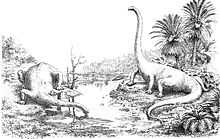Gustav Tornier

Gustav Tornier (Dombrowken (today Dąbrowa Chełmińska, Poland), 9 May 1858 – Berlin, 25 April 1938) was a German zoologist and herpetologist.
Life and career
Tornier was born in West Prussia, Kingdom of Prussia. Nothing is known about his youth and adolescence.
He studied at Heidelberg University, from which he received his doctorate (Dr. phil.) in 1892. In 1891 he had already accepted a post as an assistant in the zoological museum of the Friedrich-Wilhelms-University in Berlin. Initially he occupied himself with preparing anatomical specimens, but from 1893 he also worked in the herpetological department. When its curator, Paul Matschie, took over the mammal collection in 1895, Tornier succeeded him. In 1902, he became professor of zoology at the university, whilst later also accepting the post of head librarian at the museum (1903, assistant director of the museum (1921) and finally director ad interim of the museum (1922–1923).
He retired in October 1923 and died in 1938 in Berlin. He was interred in the Luisenfriedhof-III in Berlin-Charlottenburg.[1]
Tornier's research interests focused on amphibians and reptiles, developmental anatomy and systematics. He became the leading authority on the reptilian and amphibian fauna of German East Africa. Tornier's frog, Litoria tornieri, (an Australian endemic) was named after him, as was a large sauropod dinosaur found around 1910 in the Tendaguru formations of German East Africa, Tornieria africanus (Fraas).
Diplodocus

Perhaps unfairly, Tornier's legacy has mainly been determined by his position in the controversy surrounding the posture of the sauropod dinosaur Diplodocus carnegiei. Following the 1899 discovery of the animal in Wyoming, it had traditionally been depicted and mounted in an elephant-like stance. However, In 1909, Oliver P. Hay imagined two Diplodocus, being reptiles after all, with splayed lizard-like limbs on the banks of a river. Hay argued that Diplodocus had a sprawling, lizard-like gait with widely splayed legs,.[3] Tornier had independently arrived at the same conclusion and forcefully supported Hay's argument,[4] but the hypothesis was contested by W. J. Holland, who maintained that a sprawling Diplodocus would have needed a trench to pull its belly through.[5]
Tornier's acerbic and sometimes sarcastic reply[6] to Holland led to a minor spat, with German authorities (including Kaiser William II himself) coming down on the former's side and even considering re-mounting the Berlin copy of Diplodocus, placed there only a few years before by Holland, in a more 'reptilian' fashion.[7] In the end, however, finds of sauropod footprints in the 1930s put Hay and Tornier's theory to rest.
Selected publications
- Gustav Tornier 1884, Der Kampf mit der Nahrung: Ein Beitrag zum Darwinismus (Berlin: W. Ißleib).
- Gustav Tornier 1896, Die Reptilien und Amphibien Ost-Afrikas (Berlin: Reimer).
- Gustav Tornier 1899, "Neues über Chamaeleons", Zoolischer Anzeiger 22: 408-414.
- Gustav Tornier 1899), "Drei Reptilien aus Afrika", Zoologischer Anzeiger 22 (588): 258-261
- Gustav Tornier 1900, "Beschreibung eines neuen Chamaeleons, Zoologischer Anzeiger 23: 21-23.
- Gustav Tornier 1900. "Neue Liste der Crocodilen, Schildkröten und Eidechsen Deutsch-Ost-Afrikas", Zoologisches Jahrbuch für Systematik, 13: 579-681.
- Gustav Tornier 1901, "Die Reptilien und Amphibien der Deutschen Tiefseeexpedition 1898/99", Zoologischer Anzeiger, 24 : 61-66.
- Gustav Tornier 1904, "Bau und Betätigung der Kopflappen und Halsluftsäcke bei Chamäleonen", Zoologisches Jahrbuch für Anatomie, 21: 1-40.
- Gustav Tornier 1909, "Wie war der Diplodocus carnegii wirklich gebaut?", Sitzungsberichte der Gesellschaft Naturforschender Freunde zu Berlin 1909-4: 193-209.
- Gustav Tornier 1909, "Ernstes und lustiges aus Kritiken über meine Diplodocusarbeit" / "War der Diplodocus Elefantenfüssig?", Sitzungsberichte der Gesellschaft Naturforschender Freunde zu Berlin 1909-9:505-556.
External links
- Online version of Tornier's Der Kampf mit der Nahrung: Ein Beitrag zum Darwinismus (Berlin: W. Ißleib) (Archive.org)
- Short biography in German (Chameleons Online)
- Species named by Tornier in The Reptile Database
References
- ↑ http://www.findagrave.com/cgi-bin/fg.cgi?page=gr&GRid=23421776
- ↑ Hay, Oliver Perry., 1910, Proceedings of the Washington Academy of Sciences, vol. 12,, pp. 1–25
- ↑ Hay, Oliver Perry, "On the Habits and Pose of the Sauropod Dinosaurs, especially of Diplodocus." The American Naturalist, Vol. XLII, Oct. 1908
- ↑ Tornier, G., "Wie war der Diplodocus carnegii wirklich gebaut?", Sitzungsberichte der Gesellschaft Naturforschender Freunde zu Berlin 1909-4: 193-209. 1909
- ↑ Holland, Dr. W. J., "A Review of Some Recent Criticisms of the Restorations of Sauropod Dinosaurs Existing in the Museums of the United States, with Special Reference to that of Diplodocus carnegii in the Carnegie Museum", The American Naturalist, 44:259–283. 1910.
- ↑ Tornier, G., "Ernstes und lustiges aus Kritiken über meine Diplodocusarbeit / War der Diplodocus Elefantenfüssig?", Sitzungsberichte der Gesellschaft Naturforschender Freunde zu Berlin 1909-9:505-556. 1909
- ↑ Maier, G., African Dinosaurs Unearthed. The Tendaguru Expeditions. (Indianapolis: Indiana University Press, 2003), 72
|